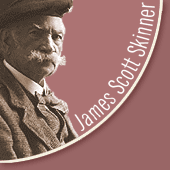




James Scott Skinner and William Scott: ‘A Guide to Fashionable Dancing’
The
Collection's Dance Entries · Changing
fashions · Francis Peacock
The Ball-Room Guide · ‘A
Guide to Fashionable Dancing’
‘The People’s Ball
Room Guide’ · Illustrated
Guide to the National Dances of Scotland
‘Highland Dancing in the Olden Times’ · Dance
Video Clips
(JSS0473-JSS0496)
 ‘Professor’ William Scott taught Skinner to dance. Dancing
ran in Skinner’s family: his father taught dance, as had his brother,
Sandy. In ‘My Life and Adventures’, Skinner tells how himself,
Scott and Scott’s wife and daughter used to make up quadrille sets
with chairs.
‘Professor’ William Scott taught Skinner to dance. Dancing
ran in Skinner’s family: his father taught dance, as had his brother,
Sandy. In ‘My Life and Adventures’, Skinner tells how himself,
Scott and Scott’s wife and daughter used to make up quadrille sets
with chairs.
When Skinner and Scott compiled these notebooks in the early 1880s, ballroom dances such as quadrilles, galops, polkas and waltzes were still as popular as ever. As in every other dance manual, the compilers stress the importance of grace and elegance in dancing.
Many variations on the quadrille are described here. Quadrilles had arrived in Scotland from France towards the beginning of the nineteenth century.
- There are five or six parts to a quadrille, each part being danced to different music
- A quadrille set consists of four couples, forming a square, rather than a circle.
- Some movements are repeated by each couple in turn, and some are danced by two couples at a time
- The original quadrilles included some fancy footwork but as the nineteenth century progressed, this became simpler
- ‘Paine’s Quadrille’ is the original quadrille imported from France (JSS0487, JSS0488, JSS0489. See also JSS0431, JSS0432, JSS0433 from ‘Dancing taught without a Master’, and JSS0910, JSS0911, JSS0912 from ‘The People’s Ball Room Guide’)
The compilers include simple dances, such as
- ‘Long Live the Queen Country Dance’ (JSS0476), which Skinner made up when he taught Queen Victoria’s tenants at Balmoral in 1868.
- ‘The Chimes of Dunkirk’ (JSS0479), kept simple so that everybody could join in. Getting everybody to join in was a very important aspect of the dancing-master’s task!
Pat Ballantyne
